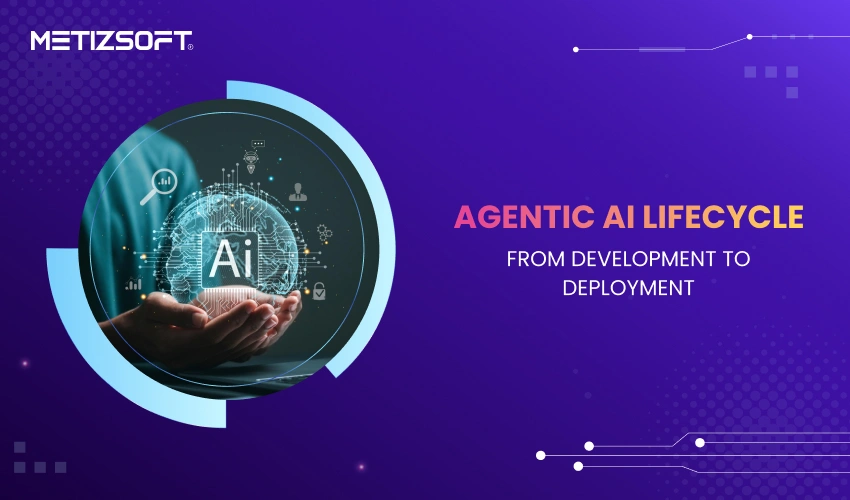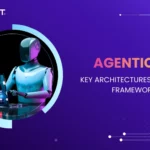
Table of Contents
Introduction
In recent years, Agentic AI has emerged as a transformative technology, shaping industries of all sizes and niches worldwide. From automating complex decision-making processes to enhancing personalized customer experiences, agentic artificial intelligence represents a new frontier in AI capabilities. But what exactly goes into building and deploying such intelligent agents? Understanding the Agentic AI lifecycle is crucial for businesses and developers looking to leverage its full potential.
This blog will explore the complete lifecycle of Agentic AI, from initial development to deployment. We have highlighted key phases, best practices, and considerations for a successful AI project. Whether you are a startup, an established enterprise, or a technology enthusiast, this guide will clarify how Agentic AI evolves and integrates into real-world applications.
What is Agentic AI?
Before diving into the agentic artificial intelligence lifecycle, it’s important to understand what Agentic AI means. Unlike traditional AI systems that perform predefined tasks, agentic AI systems are designed to act autonomously in complex environments. They possess the ability to perceive, reason, plan, and execute actions towards achieving goals with minimal human intervention.
Agentic artificial intelligence is widely used in robotics, autonomous vehicles, virtual assistants, finance, healthcare, and many other domains where dynamic decision-making is essential.
The Agentic AI Lifecycle: Key Phases
The lifecycle of Agentic AI involves multiple stages that ensure the system is effective, reliable, and aligned with business objectives. These stages include:
1. Problem Definition and Requirement Analysis
Every successful AI project starts with a clear understanding of the problem it aims to solve. This phase involves:
- Defining business goals and objectives.
- Identifying specific tasks for the agent to perform.
- Understanding constraints such as data availability, ethical considerations, and regulatory compliance.
Proper requirement analysis lays a solid foundation for the development phase and prevents costly rework later.
2. Data Collection and Preparation
Agentic AI depends heavily on quality data to learn and make decisions. In this phase:
- Relevant datasets are gathered from internal and external sources.
- Data is cleaned, labeled, and transformed into formats suitable for training.
- Techniques like data augmentation and balancing might be used to improve model robustness.
The success of AI models hinges on the quality and diversity of data fed into them.
3. Model Design and Development
With data ready, the next step is designing the AI model. This involves:
- Selecting appropriate algorithms (e.g., reinforcement learning, deep learning).
- Architecting the agent’s cognitive components, such as perception, reasoning, and action modules.
- Developing simulation environments to test agent behaviors.
Hire experienced AI developers to streamline model architecture that aligns perfectly with project goals and technical requirements. Many companies offer specialized Agentic AI Development Services to help build custom solutions tailored to specific use cases.
4. Training and Validation
The agentic AI model undergoes extensive training using the prepared datasets. Key activities here include:
- Iterative training cycles to optimize performance.
- Validation using separate test datasets to evaluate accuracy, reliability, and decision-making capabilities.
- Fine-tuning hyperparameters to enhance efficiency.
This phase may also involve transfer learning or continual learning approaches to help the agent adapt to new data over time.
5. Testing and Simulation
Before deployment, the AI agent must be rigorously tested in controlled environments. This step:
- Simulates real-world scenarios to assess the agent’s behavior and adaptability.
- Identifies potential failures or unsafe actions.
- Ensures compliance with safety and ethical standards.
Thorough testing minimizes risks and builds confidence in the AI’s operational readiness.
6. Deployment and Integration
After successful testing, the AI agent is deployed into the live environment. This stage includes:
- Integrating the agentic AI system with the existing IT infrastructure.
- Setting up monitoring tools to track performance and detect anomalies.
- Implementing feedback loops for continuous improvement based on real-world data.
Effective deployment requires close collaboration between AI developers, IT teams, and business stakeholders to ensure smooth integration and minimal disruption.
7. Maintenance and Continuous Improvement
The lifecycle doesn’t end with deployment. Continuous maintenance is vital to:
- Monitor the agent’s decisions and outcomes for accuracy.
- Update the model to handle evolving scenarios and data changes.
- Incorporate user feedback and improve functionalities.
Ongoing support helps maintain AI system relevance and maximizes long-term ROI.
Best Practices for Managing the Agentic AI Lifecycle
To successfully navigate the complex lifecycle’s of agentic AI, consider these best practices:
- Cross-functional collaboration: Involve data scientists, developers, domain experts, and business leaders throughout the process.
- Ethical AI principles: Design agents that respect privacy, transparency, fairness, and safety.
- Scalability: Build flexible AI models that can scale with growing data and evolving requirements.
- Documentation: Maintain thorough documentation of development processes, model versions, and decision logic.
- Automation: Use tools to automate data processing, testing, and monitoring to increase efficiency.
Why Invest in Agentic AI Development?
Adopting agentic AI can unlock powerful benefits such as operational efficiency, improved decision-making, and enhanced customer satisfaction. Businesses that effectively manage the AI lifecycle position themselves as leaders in innovation.
If you are looking to hire AI developers or outsource your AI initiatives, work with specialized service providers who understand the full agentic AI lifecycle. They can accelerate your project’s success and reduce risks.
Conclusion
The Agentic AI lifecycle is a comprehensive journey from ideation to deployment and continuous improvement. Each phase is critical to building intelligent agents capable of autonomous and adaptive decision-making. By carefully managing this lifecycle, businesses can harness the true potential of Agentic AI to drive competitive advantage.
Whether you are planning your first AI project or looking to scale your existing AI capabilities, understanding and implementing the lifecycle stages effectively is key to success. Remember, investing in skilled AI development talent and following best practices will help you build robust, scalable, and ethical agentic AI systems.
Discover More About Agentic AI
- Agentic AI V/S AI Agent
- What is Agentic AI
- Agentic AI in Retail Business
- Traditional AI V/S Generative AI
- Agentic AI in the Healthcare Industry
AboutManthan Bhavsar
Related Posts
How Do Deep Learning Models Optimize Shopify Store Performance?
Deep learning models improve Shopify store performance by leveraging smart technologies such as predictive analytics, dynamic...
Here’s What Matt Cutts (former head of web spam at Google) Is Doing Now After Leaving Google?
Matt Cutts had been talking for a long time after leaving Google. There have been frequent rumors about Matt and his extended...

